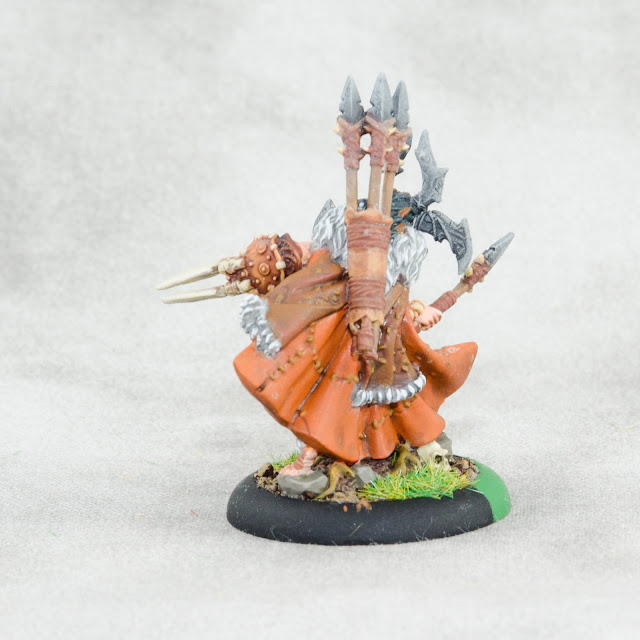I've written a brief tutorial on how I photograph my minis. It's a simple setup designed to get the best results with the least complexity. I wrote it assuming little familiarity with photography. If you're not satisfied with the photos you're taking, have a read and see if anything below strikes a chord.
I've also included some "problem" photos as examples.
Lights
The most important part of the setup is not the camera, but the lighting. There's a limit to what your camera can do and without good lighting, you're fighting an uphill battle.
What's good lighting? In the context of miniature photography, there are three qualities to light that matter the most - brightness, diffusion, and color.
Ideally, you want to flood a miniature with enough diffuse light that makes for a bright image, but doesn't cast shadows onto the background. Background shadows are really distracting.
- Brightness - room lighting is typically not enough. You'll want to use at least two external lights positioned to the side and front. [image here] If the camera has a flash on it, I recommend using it. The downside of using a bright flash is that it's very direct and usually bright, which will leave shiny spots on the model. However, if you're supplementing extra lights, it shouldn't fire very brightly. They're pretty smart that way.
- Diffusion - the best case for lighting is when you look at the miniature and you can't tell where the light source is. Bright, diffuse lights will wash out the background shadows very well. I made a light box out of a cardboard box and tracing paper. It does a pretty good job.
 |
| The background shadows are a result of too much direct light, probably from the main camera flash. |
- Color - this one is a bit harder to control. I look for "daylight" colored lights or "warm" lights. The color of the light affects what the photo technology refers to as White Balance. Fortunately, this is one of the easiest things to correct for in photo editing software.
 |
| This is an example of poor white balance and too intense directional lighting |
Camera
The camera is the least important part of the setup. You can get good results with a craptacular camera (even a camera phone) if you follow some basic guidelines. Most cameras now allow you to select various shooting modes including "aperture priority." That's about all you need in a camera.
"Macro mode" is not needed. In fact, I recommend that you don't use it at all. More on that below.
Action
Here's how to do it in a few bullet points.
- Use a Tripod
- Avoid "macro mode"
- Set your camera's shooting mode to aperture priority and select an aperture between f/8~11
- Move the camera away from the subject and zoom in
- Turn on the flash if you have it
- Unless you have a remote trigger (if you're not sure, then you don't) use the camera's timer function to snap the picture.
A tripod is essential. With the amount of light present in your house, you probably won't be able to photograph at a high aperture using a shutter speed fast enough to eliminate motion blur, especially when zooming in. As a rule of thumb, if my focal length is 50 mm (which I don't consider wide angle, or zoomed in), I won't go slower than 1/60th of a second on the shutter. If you double the focal length, increase the shutter speed accordingly. At 100 mm, I want at least 1/125 sec. The tripod allows you to use a much slower shutter speed without losing sharpness to motion blur. So, it's strongly recommended that we use a tripod. You're not as steady as you might think.
Avoid "macro mode." Macro mode lets you get really close to your subject. In this case, you don't want to be close, you want to be far. More on that below.
An aperture around f/8~11 will increase your depth of focus, helping to keep the whole miniature sharp. Moving away and zooming in will flatten the image and make the miniature stand out from the background. It's a neat effect.
 |
| Notice how the ax is out of focus. This resulted from using a very low aperture. |
The on-camera flash is optional. If you want more light on the front of the model, or if you don't have enough lights, you can use it. That's something you'll have to play with.
Finally, and critically important, don't hand-trigger the shot. Since we're using a small aperture (high number) the camera will likely compensate by using a slow shutter, unless you have a ton of extra light. In that case, the image will be very sensitive to motion blur. Meaning, if the camera moves, the image will blur. It only takes a tiny amount and because we're zooming in, that motion will be exaggerated.
In summary
Use a lot of diffuse light, shoot on aperture priority mode between f/8~11, always use a tripod, and don't trigger by hand. A light box can be made really cheaply and helps out a great deal.
I'd like to develop this tutorial more, so if you have questions, please don't hesitate to ask them.
So, what does it look like when everything comes together?
 |
| This is one of my favorite shots. The detail stands out and the light isn't harsh. The little bit of shine seems purposeful. |
Good shooting!























